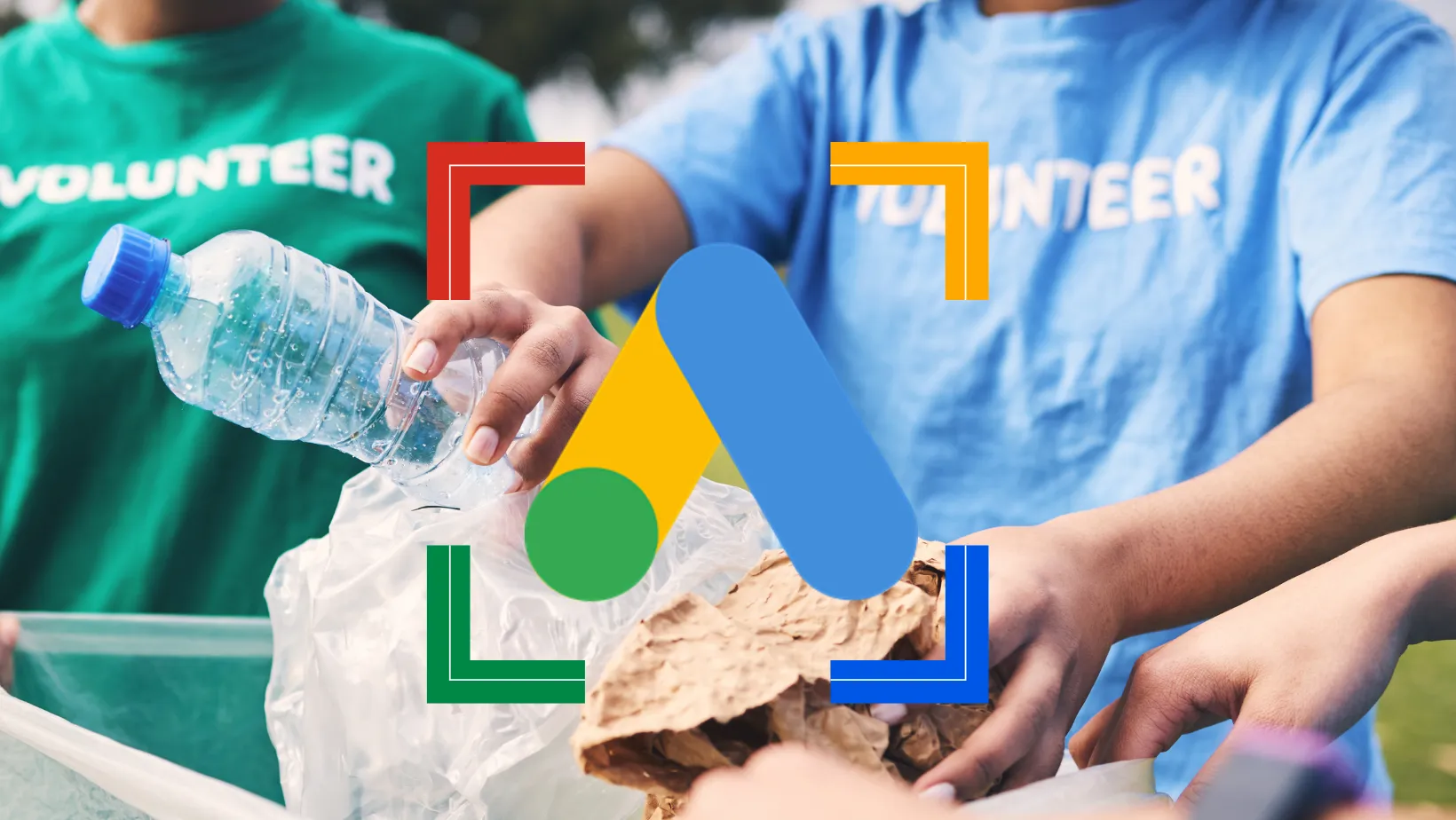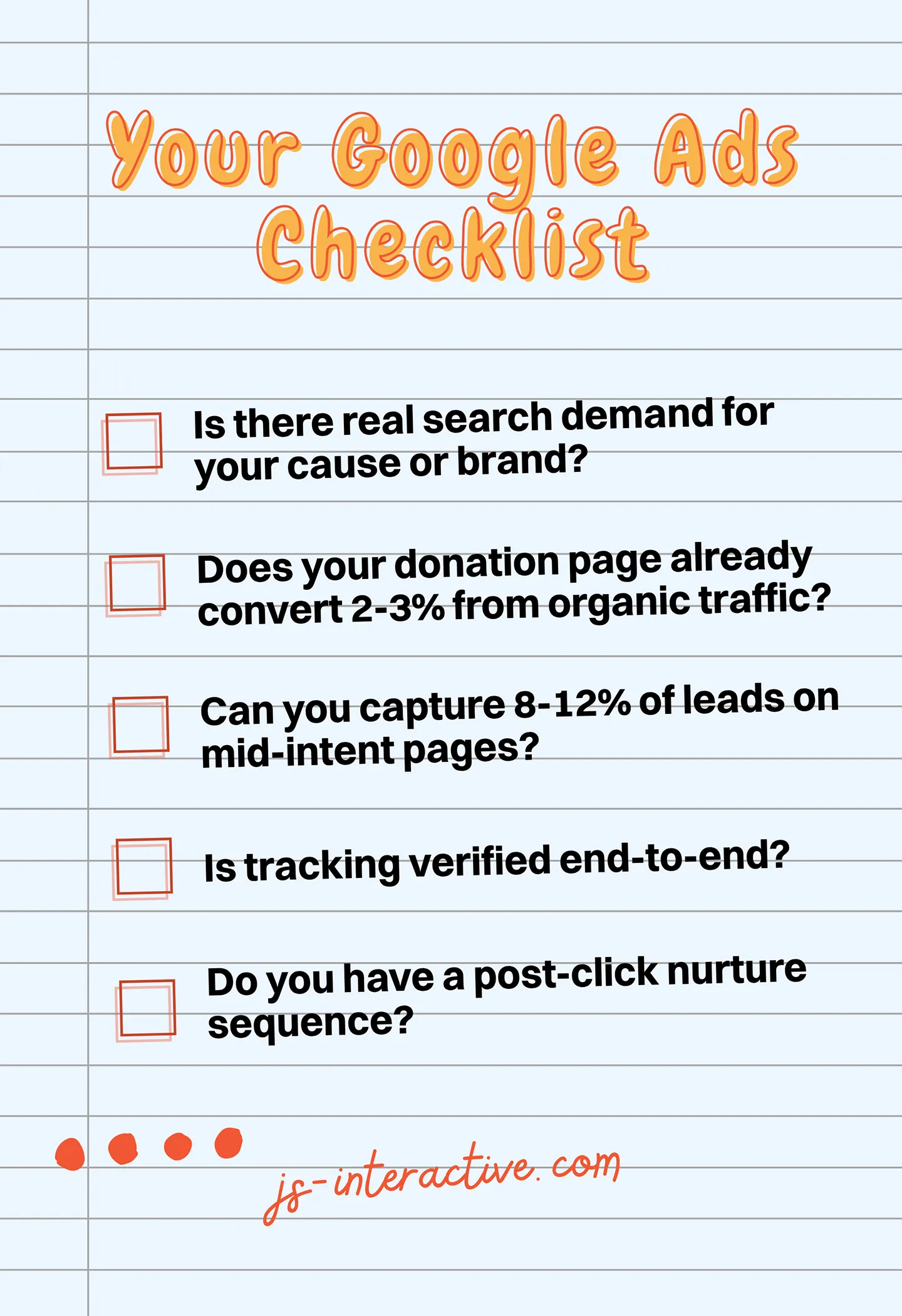Google Ads for Nonprofits: What Your Campaign Can and Can’t Do

Over the past few months, we’ve seen more nonprofits reaching out after receiving Google Ad Grant funds.
Many are excited to put that $10,000 credit to use; however, only a few have a clear plan for what comes next.
Ads can drive clicks, event signups, or even one-time gifts. What they cannot do is build trust. That happens through follow-up, proof of impact, and a donation experience that feels genuine from start to finish.
For many organizations, Google Ads seems like the answer to visibility.
But visibility does not equal loyalty.
Real growth comes from the systems that nurture people after they find you: thoughtful messaging, consistent updates, and transparency about where their money goes.
Google Ads can absolutely help a nonprofit grow, but only when the foundation is ready to earn that attention.
A Quick Look at Google Ad Grants
Google Ad Grants is a program that gives eligible nonprofits free advertising credit on Google Search. It allows organizations to appear in search results when people look for ways to donate, volunteer, or learn more about their cause.
The program’s purpose is simple: help nonprofits and mission-based organizations connect with the right audience and share their mission more widely. It can raise awareness, drive traffic, and support campaigns that align with a nonprofit’s goals.
Like any tool, its impact depends on how it’s used. The grant can open the door to new supporters, but it still takes a strong message and a clear path to give people a reason to act.
When the foundation is ready, the grant can do real work, starting with understanding where Google Ads can make a difference.
How Google Ads for Nonprofits Can Help
Google Ads are most effective when they reach people who are actively searching for causes like yours. They help your organization show up at the right moments when someone is looking to donate, volunteer, or attend an event that aligns with your mission.
Capture Existing Intent
Most people using Google are already searching for something specific.
Ads let you meet that search intent in real time.
When someone types “donate to local food bank” or “volunteer near me,” your ad can guide them straight to your site. This is where the grant performs best, turning existing interest into action rather than trying to create it from scratch.
Protect Your Brand
Even nonprofits need brand protection in search results.
When people search for your organization’s name, your own ad should appear first.
Bidding on your own brand name in a campaign helps:
- Prevents confusion with similarly named organizations
- Keeps competitors from bidding on your name
- Reinforces credibility: Running a branded campaign builds consistency between what people search and what they see, which increases trust.
Promote Events and Campaigns
Google Ads can give momentum to time-sensitive campaigns, community events, or seasonal drives.
A well-timed ad can help fill seats, recruit volunteers, or promote ticket sales.
Use clear calls to action and highlight deadlines to create urgency that encourages people to act right away.
Target by Location and Timing
Not every cause needs to reach everyone.
Ads can focus on specific cities, zip codes, or even times of day when supporters are most active. This precision helps smaller organizations spend their ad budget efficiently and reach the people most likely to engage.
Measure What Matters
The best part of Google Ads is measurability.
With proper tracking in place, you can see which keywords, ad copy, and landing pages drive results. This data helps shape stronger campaigns and ensures future spending goes toward what truly supports your mission.
6 Reasons Your Google Ads Campaign Falls Short
Google Ads can drive attention, but they cannot fix weak foundations. Campaigns only perform when strategy, tracking, and trust work together.
Effective ads connect intent to action. When that connection breaks — when the message, page, or goal doesn’t align —results drop fast.
Before you spend more, it’s worth knowing where campaigns typically lose traction and how to avoid the same mistakes.
1. Ad Campaigns Fall Short When Demand Isn’t There
If people aren’t searching for your cause, even the best campaign won’t gain traction.
Ads only capture intent that already exists.
For newer or niche nonprofits, it’s often better to invest first in building organic awareness (e.g., SEO, social media, educational blogs) or partnerships that build recognition before investing time in ads.
2. They Lack Reliable Data Tracking
Google ads are only as effective as the tracking behind them.
Without accurate data, you can’t measure what’s working or what’s not. Tools like Google Tag Manager and properly configured conversion events help you see which ads drive actions, like donations or volunteer signups.
Accurate tracking lets you see:
- Which ad or keyword led to a donation or sign-up
- Which counts as a meaningful action, such as a completed donation or form submission
- Where users drop off, so you can identify and fix weak points in the process (or funnel)
Without this data, there’s no way to improve performance or justify the budget. When every step is measured, you can see what drives impact and invest in what works.
3. They’re Limited by Grant Rules
The Ad Grant program has specific requirements that can limit how you test campaigns.
Nonprofits must maintain a 5% click-through rate each month, and ads must use mission-aligned keywords.
These rules keep ads relevant but can make experimentation harder. Regularly reviewing performance and pausing low-CTR keywords helps maintain eligibility and efficiency.
4. They Underperform on Weak Donation Pages
Even the best ad won’t convert if the donation page doesn’t feel trustworthy. If the page loads slowly, looks outdated, or doesn’t clearly show how donations are used, people hesitate to give.
A strong donation page helps people feel confident about their choice. It can include:
- Testimonials from real donors or community members.
- Visible certifications or partnerships that verify your organization’s credibility.
- Clear examples of impact, such as photos, stories, or dollar-to-outcome breakdowns.
- Simple, secure forms that make giving quick and easy.
When people can see that their money will make a difference and their information is safe, they’re far more likely to complete the gift.
5. Ad Campaigns Can’t Build Loyalty on Their Own
One click doesn’t create a loyal donor. Sustained giving comes from thoughtful follow-up that builds connection and trust.
A strong post-click strategy might include:
- Welcome emails that thank donors and reinforce the impact of their first gift.
- Impact updates that show real results or share stories from the field.
- Personal invitations to become monthly donors once trust is established.
Ads open the door, but your communication after the click determines whether supporters stay involved.
6. They Face Barriers With Sensitive Causes
Not every topic qualifies for every ad.
Sensitive areas like mental health, addiction recovery, or crisis support may face additional ad approval steps or limited targeting options.
It’s essential to review Google’s advertising policies early to avoid unexpected campaign rejections.
Google Ads can do a lot for nonprofits, but they work best as an amplifier, not a foundation.
5 Questions to Ask Before Running Your Google Ads Campaign
Before you spend a dollar on Google Ads, make sure the foundation is strong enough to support the traffic.
Each of these questions points to a system that determines whether your ads will drive real results or fade into obscurity.
1. Is There Real Search Demand?
Ads only work if people are already searching for what you offer.
Start by checking search volume in tools like Google Trends or Keyword Planner to see if there’s meaningful interest in your cause.
If demand is low, focus first on awareness and partnerships before spending on ads. Otherwise, you risk paying for traffic that was never there to begin with.
2. Does Your Donation Page Already Convert 2–3% Organically?
If visitors from organic search aren’t donating, ads won’t fix that.
A healthy conversion rate shows that your page design, message, and user experience already earn trust. Fixing the donation experience before increasing traffic ensures every future ad click has a real chance to convert.
3. Can You Capture 8–12% of Leads on Mid-Intent Pages?
Not everyone is ready to give on their first visit.
Mid-intent pages, such as event signups, volunteer opportunities, or downloadable resources, can capture interest earlier in the journey.
A simple form, checklist, or newsletter signup keeps your organization connected until those visitors are ready to take the next step.
4. Is Tracking Verified End-to-End?
You can’t improve what you can’t measure.
Every ad click should be traceable from the first impression to a donation, form submission, or RSVP.
Test every piece of the process: form fills, thank-you pages, and confirmation messages. Without accurate tracking, there’s no way to measure ROI or optimize performance.
5. Do You Have a Post-Click Nurture Sequence?
The real work starts after someone clicks.
New supporters should immediately enter a follow-up sequence that builds connection and trust. This may include:
- A welcome email thanking them for taking action.
- A story or impact update showing how donations make a difference.
- A monthly giving invitation within the first two weeks.
If this system isn’t in place, new interest fades fast, and recurring giving never takes root.
If you answer “no” to most of these, the next step isn’t more traffic. It’s strengthening your page, tracking, and follow-up before scaling spend. When those systems are solid, Google Ads becomes a proper growth channel instead of a guessing game.

Google Ads for Nonprofits Backed by 15 Years of Marketing Experience
JS Interactive helps nonprofits turn Google Ads clicks into meaningful support.
The goal isn’t just visibility; it’s building trust that leads to action.
We focus on the essentials: a clear message, a strong donation experience, accurate tracking, and follow-up that keeps supporters connected.
When those elements work together, Google Ads becomes a growth tool, not just another traffic source.
If you’re ready to turn attention into impact, contact us today to get started.